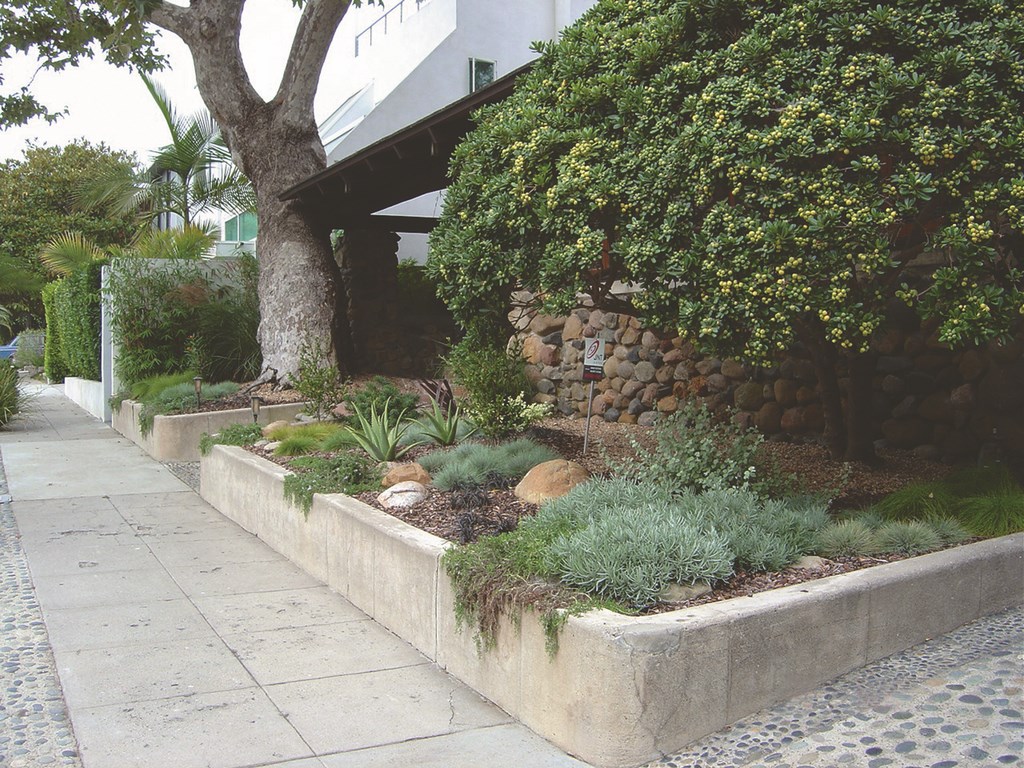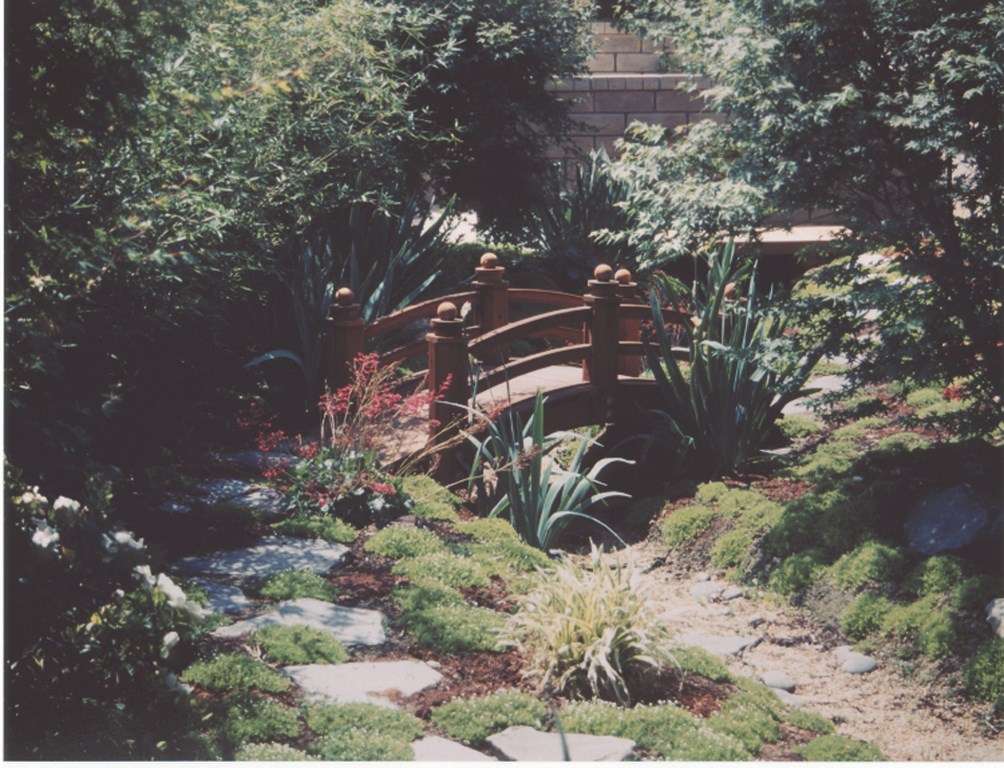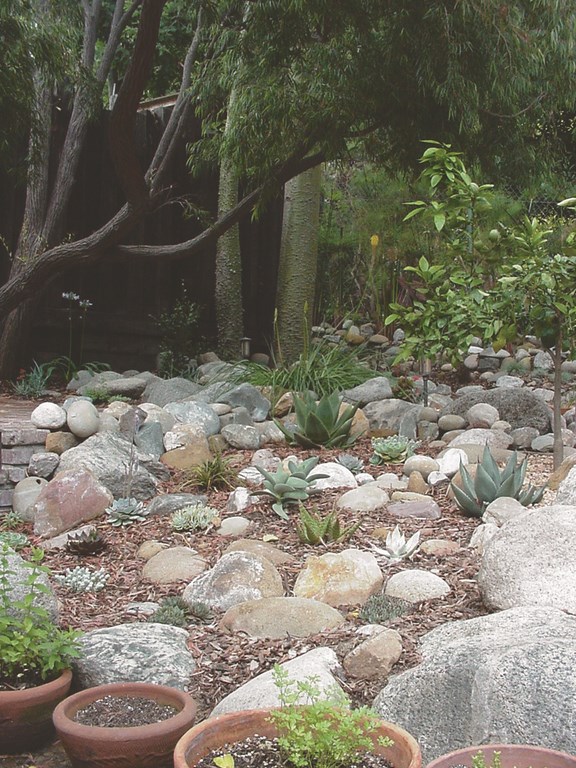Rocky Pleasures

Rocks are, in my opinion, among the most versatile of all elements that can be added to landscape designs. As was discussed in my last column, they can be used to add texture or dimension or retain soil; they can also be used to add background or hide eyesores, and there are myriad other uses creative designers can find for them.
Of course, different design styles call for different uses of rocks, stones and pebbles. An Asian garden, for example, might use them to simulate or represent water or mountains in a landscape, while the very same stones used in a cottage or natural setting might serve no purpose beyond providing a place to sit or a focal point that sets off plants behind it.
Here are some suggestions for using rocks in a variety of design styles:
[ ] Contemporary. Here, rocks of various sizes and shapes can be used to complement or reinforce the strong planes and lines found in contemporary architecture. Beds of gravel, for instance, can be used to continue flat planes beyond hardscape surfaces, as with concrete pathways bordered by gravel beds with minimal plantings – particularly effective in ultra-contemporary settings.
| In this Asian-style landscape, the rocks in the wall and planter set off plant forms as well as the exposed-aggregate details below. |
Boulders serve very well when placed by themselves as focal points in these gardens. In fact, truly unusual stones – large specimens covered with unique striations or flecks of reflective quartz, for example – may even be used as artwork within these landscapes.
[ ] Asian. Gravel and small pebbles are extensively used in Zen gardens, which are usually devoid of plant life. They’re also common, as was mentioned above, in lush Asian gardens, where they symbolize rivers or other bodies of water. Larger flat stones are frequently used as stepping stones through forested paths, while boulders and larger rocks serve to represent distant mountains. These large specimens are also key stationary elements in Zen gardens.
[ ] Cottage or Natural. There are so many uses for rocks in cottage or natural settings that you’d be hard pressed to find one that doesn’t use them. Gravel and pebbles make great pathways – indeed, most classic cottage or English gardens use gravel pathways as transitions from one area to another – and they even serve to pave driveways within large-scale cottage designs.
These pathways are very low maintenance, but they’ll require replenishing every few years if heavily trafficked. Flagstones work well in providing access to areas that need to be tended or as pathways through dense plantings. For their part, boulders work beautifully in providing respite for “weary” garden visitors while setting off strappy-leafed plants or adding firmer texture to an otherwise medium-to-soft-textured landscape.
| Rocks “flow” beneath the bridge to suggest a streambed in another Asian-style garden, this one with a distinctly Japanese flavor. |
[ ] Woodland. To gain the proper rocky effect in these spaces, you almost need to stand in one spot and cast rocks in all directions – at least that’s the way it looks when you hike into a woodland setting and take the time to observe just how randomly rocks appear in the landscape.
Think of retreating glaciers dropping rock material out of their frozen massiveness: These rocks would never be lined up or evenly piled or clustered, and all would literally have the entirely natural appearance of being unplanned. Pebbles and small stones are scattered, flatter stones are typically observed beside water and large rocks are all over the place, quite unordered.
[ ] Traditional. With a more traditional home in, for example, the ranch style, gravel and pebbles make great pathways and outstanding dog runs. Flagstone and larger rocks can be used here, too, in much the same way they appear in a cottage design. The key here – and in all other styles, in fact – is to use moderation in developing an approach: Too many rocks in the wrong places will draw visitors’ eyes away from plants or other design elements that are more properly emphasized!
WHAT ABOUT PLANTS?
Just about any plant will work in combination with rocks, pebbles and stones, but there are certain pairings that offer more interesting design possibilities than others. Let me explain what I mean by suggesting some settings and then filling them with plants.
[ ] Boulders on borders. Try a strappy-leafed plant behind the boulder, such as Agapanthus, Clivia or one of the larger grasses, such as Miscanthus, Cortaderia (Pampas grass), or Pennisetum. Just make sure the plant and the rock are on the same scale: A small boulder with big grass behind it will get lost, while Agapanthus behind a large boulder will be entirely overshadowed.
[ ] Flagstone pathways. If you’re not using gravel to surround your flagstone, a durable groundcover will do nicely. Of course, maintaining the plants will take considerable watering, which might be an issue if your client is concerned about the stones being slippery when wet.
| This rock garden features a variety of carefully placed rocks interspersed with succulents that complement rather than compete with the stones. |
If water isn’t an issue, try Baby Tears (Soleirolia soleirolii) or Ophiopogon ‘Dwarf Kyoto’ (Dwarf Mondo Grass) in shaded areas, or Blue Star Creeper, Sagina subulata (Irish or Scotch Moss) or Zoysia tenuifolia in the sun. Sod is also a good choice for sunny spots and has the advantage of being low maintenance: It’s easy for a gardener to run a lawnmower right over both the sod and flagstone while tending to the rest of the lawn.
[ ] Gravel planter beds. You have a variety of options here, no matter whether your planter beds have geometric shapes or an organic appearance. In these cases, however, I tend to shy away from plants that get woody or rangy, as they’re completely exposed and become less and less attractive with time.
Instead, I opt for cactus and succulents – great rock garden plants – as well as junipers and many dwarf specimens. I also like to use the more upright grasses, such as Juncus, Festuca, and Baumea. Acer palmatum (Japanese maple) also works extremely well when surrounded by a gravel base.
[ ] Rock gardens. As the name implies, these are gardens composed primarily of rocks, with plants used to add visual interest and a break from the baseline colors and textures. Here, I like to use Echeverias, Sempervivums, Dudleyas and other succulents. I have also used Kniphofia (Red Hot Poker) surrounded by rocks.
The focal point in this type of design should, of course, be the rocks and the ways they are collected and arranged. As a result, plants should be of modest scale (relative to the rocks) or, if they’re larger, should not be placed in ways that obscure views of the rocks.
Placing a tree in the middle of a rock garden is fine, for example, as long as the branches of the tree don’t block an observer’s overall appreciation of the rock garden (assuming that’s the main focus of the design). Rock selection is also of obvious importance in these gardens, with a premium on specimens of varying shapes, sizes and even color.
GIVE IT A TRY
These are just some of the situations in which using rocks makes sense in garden design – and I haven’t even gotten into the ways these materials can be used to make visual transitions from landscapes to watershapes.
Don’t hesitate to dig in: It’s as simple as planning for a few strategically placed boulders in a garden you’re designing and experimenting with plants around them. And if you apply a “less is more” attitude, it will be all that much easier to maintain the all-important balance between the architecture and landscape style you’re using with the rocks you incorporate.
Stephanie Rose wrote her Natural Companions column for WaterShapes for eight years and also served as editor of LandShapes magazine. She may be reached at [email protected].













